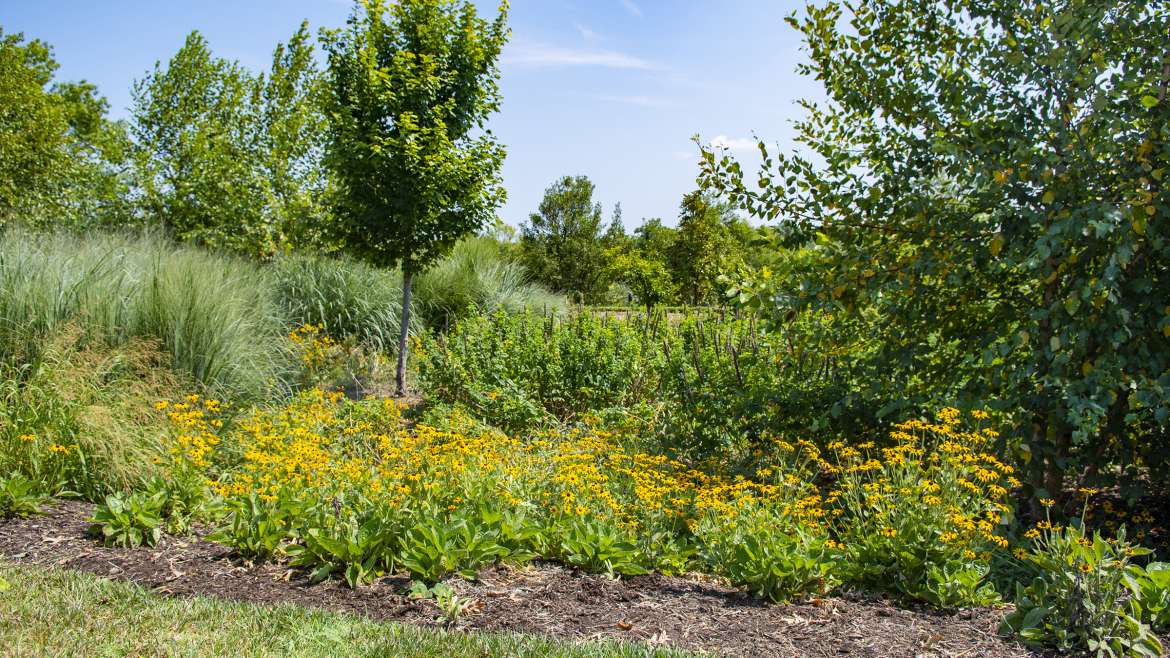In the previous two articles, we have looked at designing and planting your own rain garden. The next step is to ensure its long-term success by caring for and monitoring its health. In this third and final article of our series on rain gardens, we’ll guide you through the essential maintenance and monitoring practices to keep your rain garden thriving, beautiful, and functional.
Rain Garden Maintenance: Mulching, Weeding, and Pruning
A well-maintained rain garden requires minimal upkeep, but there are a few essential tasks to keep your garden healthy and attractive:
- Mulching: Apply a 2-3 inch layer of organic mulch around your plants to conserve moisture, suppress weeds, and regulate soil temperature. Replenish the mulch as needed to maintain the desired depth.
- Weeding: Regularly remove weeds from your rain garden to prevent them from competing with your native plants for resources. Hand-pulling or using a small hand tool is usually sufficient for removing weeds without damaging your garden’s structure.
- Pruning: Prune your plants as needed to maintain their shape, promote flowering, and remove dead or damaged branches. Pruning practices may vary depending on the plant species, so consult a local gardening guide for the best pruning techniques for your specific plants.
Monitoring Your Rain Garden: Assessing Functionality and Biodiversity
Keeping an eye on your rain garden’s performance and biodiversity ensures it continues to meet its ecological and aesthetic goals:
- Functionality: Regularly observe your rain garden during and after rain events to ensure it’s effectively capturing and infiltrating stormwater. If water is pooling for more than 24-48 hours, assess the cause and make necessary adjustments to improve infiltration.
- Plant health: Monitor your plants for signs of stress, such as wilting, yellowing, or stunted growth. These symptoms may indicate issues with soil moisture, pests, or diseases. Address problems promptly to prevent further damage to your garden.
- Biodiversity: Keep an eye out for visiting birds, butterflies, and other beneficial insects. Their presence indicates a healthy, thriving ecosystem within your rain garden.
As you care for your rain garden, you may find the following products on Amazon helpful:
- CobraHead Original Weeder & Cultivator Garden Hand Tool: This versatile weeder and cultivator make removing weeds from your rain garden quick and efficient.
- Natural Cedar Shavings Mulch: An organic mulch that helps conserve moisture, suppress weeds, and regulate soil temperature.
- Fiskars Bypass Pruning Shears: These pruning shears make trimming and shaping your rain garden plants easy and efficient.
- National Audubon Society Field Guide to North American Birds: This field guide will help you identify the birds visiting your rain garden and deepen your appreciation for the wildlife it supports.
- Stokes Butterfly Book: The Complete Guide to Butterfly Gardening, Identification, and Behavior: Discover more about the butterflies that may visit your rain garden and learn how to attract even more with this comprehensive guide.
In summary, maintaining and monitoring your rain garden is crucial for its long-term success, beauty, and ecological impact. By following the maintenance practices outlined in this article, such as mulching, weeding, and pruning, you can ensure your garden remains healthy and attractive. Additionally, monitoring your rain garden’s functionality and biodiversity will help you address any issues promptly and enjoy the flourishing ecosystem you’ve created.
With the completion of this series on rain gardens, you are now equipped with the knowledge and tools needed to design, plant, and care for your very own rain garden. Embrace this sustainable, water-wise landscaping approach and enjoy the benefits of increased biodiversity, improved stormwater management, and the satisfaction of creating a beautiful, ecologically responsible outdoor space.




